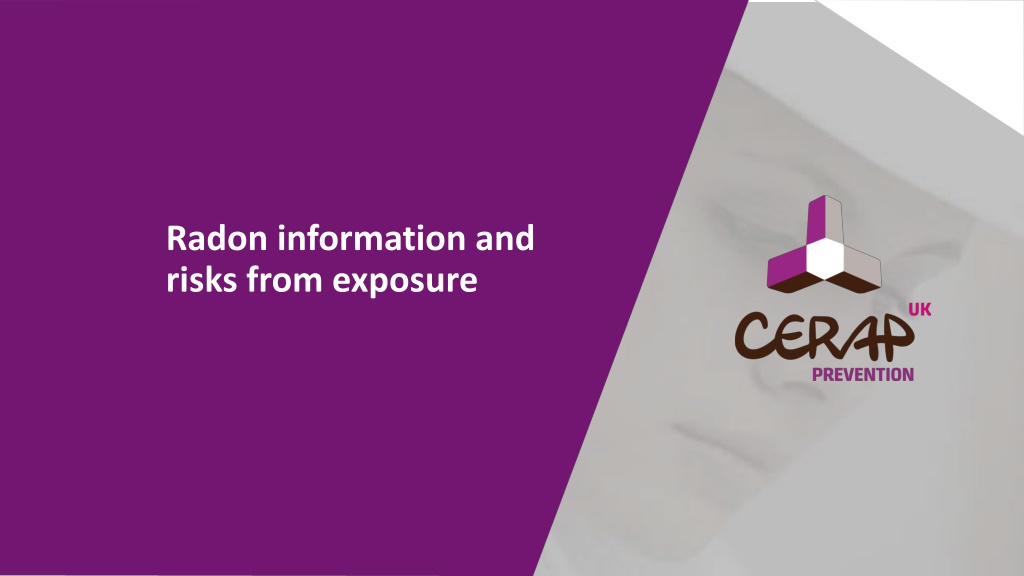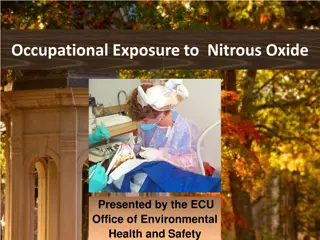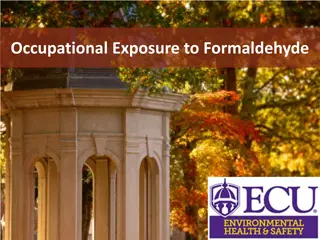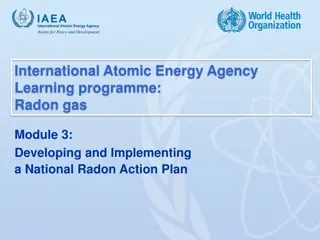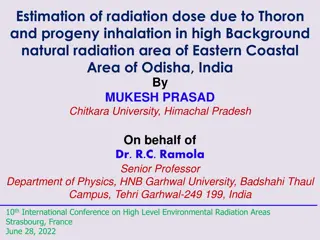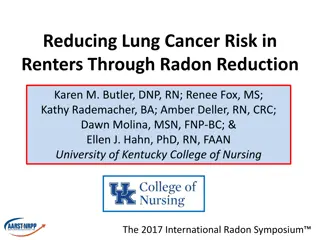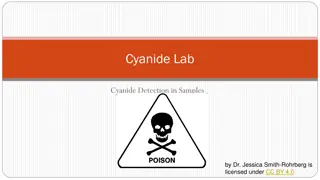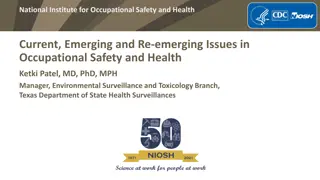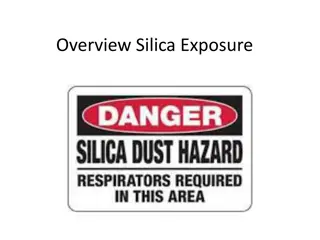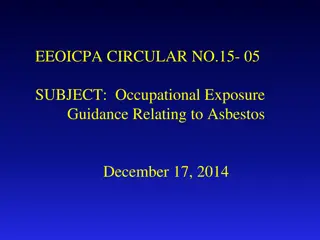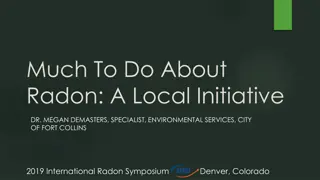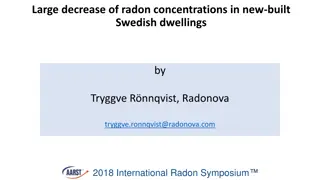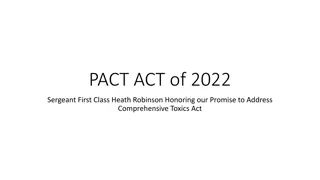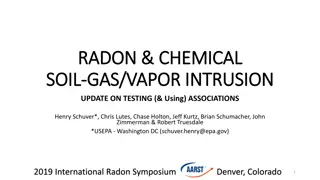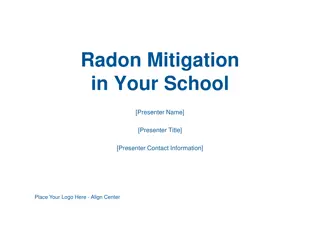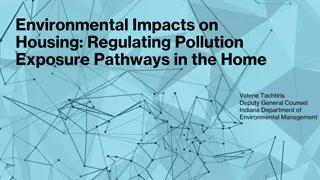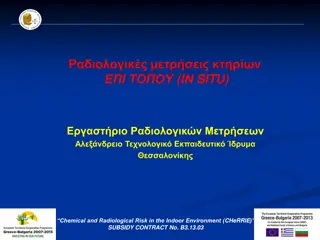Understanding Radon Exposure Risks and Prevention Measures
Radon is a colorless, odorless radioactive gas present in rocks and soils. It can enter buildings through cracks and pipes, posing health risks like lung cancer. Exposure to radon can lead to radiation damage to cells and increase the risk of cancer. It's essential to be aware of radon levels in indoor spaces and take necessary precautions to reduce exposure.
Download Presentation

Please find below an Image/Link to download the presentation.
The content on the website is provided AS IS for your information and personal use only. It may not be sold, licensed, or shared on other websites without obtaining consent from the author. Download presentation by click this link. If you encounter any issues during the download, it is possible that the publisher has removed the file from their server.
E N D
Presentation Transcript
Radon information and MOJ Prison Staff Justification risks from exposure
What is Radon? Radon is a colourless, odourless radioactive gas. It is formed by the radioactive decay of the small amounts of uranium that occur naturally in all rocks and soils. Radon is everywhere; formed from the uranium in all rocks and soils. Radon is outdoors everywhere and indoors in many areas the radon levels are low and the risk to health is small.
How does Radon enter a building ? Radon is continuously expelled from the ground and strata (layers of rock) Buildings create vacuums that draw in radon Increased vacuum during winter due to heating Gas permeating from the ground enters through cracks, pipework (drains, water pipes) floor voids Generally, the first point of entry is the basement or ground floor
Where is Radon? The darker the colour on the radon maps, the greater the chance of a high radon level in a building. However not all buildings, even in the darkest areas, have high levels.
What has happened? A Radon survey carried out has shown readings above the action levels. These readings mean that some people may have received radiation dose above the legal dose limit (other persons) of 1 milli sievert (1mSv). This limit of 1 mSv is set for a calendar year. The legal dose limit for a classified work in the UK is set at 20mSv.
How can radiation be harmful to people? The human body is made up of billions of cells Ionising radiation can damage these cells if we are exposed If high doses are received, then cells can be destroyed, or mutations can occur which go on to cause cancerous tumors
How can radon be harmful to us? The radioactive elements formed by the decay of radon can be inhaled and enter our lungs. Radon- 222 Inside the lungs, these elements continue to decay and emit radiation, most importantly alpha particles. These are absorbed by the nearby lung tissues and cause localised damage. This damage can lead to an increased risk of lung cancer.
What are the risks from exposure to Radon ? Inhalation of radon Most Radon gas that is inhaled is immediately exhaled and presents a low risk. Short term exposure will not significantly add to the risk, so there is no need for undue concern (UKHSA). Long term exposure to high concentrations of radon can increase your risk of developing lung cancer it is organ specific. There is a further increased risk for people who smoke.
What symptoms may I get? There are many different common symptoms linked to lung cancer, however these can also be caused by other medical conditions. Symptoms may include :- having a new cough or a cough most of the time getting out of breath doing the things you used to do without a problem coughing up phlegm (sputum) with blood in it having an ache or pain in the chest or shoulder reoccurring or unresolved chest infections losing your appetite feeling tired all the time (fatigue) unexplained weight loss If you notice any symptoms or changes get them checked out by your GP as soon as possible
How significant are the health risks ? Activities which carry a death risk of 1 in 20 000 :- Smoking 75 cigarettes (15 Sv per cigarette) Travelling 2500 miles by car Canoeing for 5 hours Rock climbing for 75 minutes All of the above examples would equate to exposure in radiation dose of 1 mSv
How to help reduce radon build up Radon build up can easily be controlled by effective ventilation. Radon- 222 By simply opening windows in our homes can be an effective way of reducing radon concentrations. In higher radon affected areas additional methods maybe required, such as forced ventilation.
What is being done to solve the problem? Areas affected have been identified and controls to limit exposure have been introduced on the advice of the Radiation Protection Adviser Improvements to the ventilation in affected areas is to be completed to ensure the areas are safe and below any action levels. Where required on the advice of the RPA, monitoring of radon levels will be put in place. Real time monitoring will determine if improvements are effective. Passive monitoring will determine the radon concentrations present (3 month test) The results of Radon Monitoring are adjusted to reflect for seasonal variations in the concentrations of Radon
What next ? Further communication and support will be provided to those persons affected as soon as possible once an exposure assessment has been completed. Speak to your HSF team or your line manager if you have any concerns. Support is also available from Employee assist : Call the confidential helpline on 0800 019 8988 - open 24 hours a day, 7 days a week or visit the PAM Assist website - username: HMPPS, password: HMPPS1 (use Firefox or another modern browser) Further information on Radon can be found via the UKHSA website UKradon - FAQ (ukhsa-protectionservices.org.uk)
